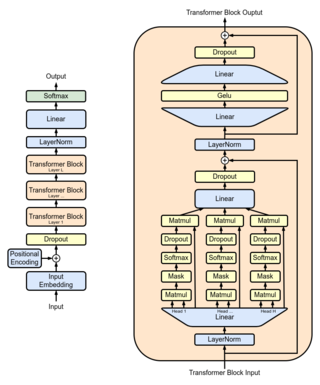
A chatbot is a software application or web interface that is designed to mimic human conversation through text or voice interactions. Modern chatbots are typically online and use generative artificial intelligence systems that are capable of maintaining a conversation with a user in natural language and simulating the way a human would behave as a conversational partner. Such chatbots often use deep learning and natural language processing, but simpler chatbots have existed for decades.

OpenAI is a U.S. based artificial intelligence (AI) research organization founded in December 2015, researching artificial intelligence with the goal of developing "safe and beneficial" artificial general intelligence, which it defines as "highly autonomous systems that outperform humans at most economically valuable work". As one of the leading organizations of the AI spring, it has developed several large language models, advanced image generation models, and previously, released open-source models. Its release of ChatGPT has been credited with starting the AI spring.
Artificial intelligence is used in Wikipedia and other Wikimedia projects for the purpose of developing those projects. Human and bot interaction in Wikimedia projects is routine and iterative.

Artificial intelligence art is any visual artwork created through the use of artificial intelligence (AI) programs.
Generative Pre-trained Transformer 3 (GPT-3) is a large language model released by OpenAI in 2020. Like its predecessor, GPT-2, it is a decoder-only transformer model of deep neural network, which supersedes recurrence and convolution-based architectures with a technique known as "attention". This attention mechanism allows the model to selectively focus on segments of input text it predicts to be most relevant. It uses a 2048-tokens-long context, float16 (16-bit) precision, and a hitherto-unprecedented 175 billion parameters, requiring 350GB of storage space as each parameter takes 2 bytes of space, and has demonstrated strong "zero-shot" and "few-shot" learning abilities on many tasks.

DALL·E, DALL·E 2, and DALL·E 3 are text-to-image models developed by OpenAI using deep learning methodologies to generate digital images from natural language descriptions, called "prompts."
Prompt engineering is the process of structuring text that can be interpreted and understood by a generative AI model. A prompt is natural language text describing the task that an AI should perform.
LaMDA is a family of conversational large language models developed by Google. Originally developed and introduced as Meena in 2020, the first-generation LaMDA was announced during the 2021 Google I/O keynote, while the second generation was announced the following year. In June 2022, LaMDA gained widespread attention when Google engineer Blake Lemoine made claims that the chatbot had become sentient. The scientific community has largely rejected Lemoine's claims, though it has led to conversations about the efficacy of the Turing test, which measures whether a computer can pass for a human. In February 2023, Google announced Bard, a conversational artificial intelligence chatbot powered by LaMDA, to counter the rise of OpenAI's ChatGPT.

Midjourney is a generative artificial intelligence program and service created and hosted by the San Francisco–based independent research lab Midjourney, Inc. Midjourney generates images from natural language descriptions, called prompts, similar to OpenAI's DALL-E and Stability AI's Stable Diffusion. It is one of the technologies of the AI boom.

ChatGPT is a chatbot developed by OpenAI and launched on November 30, 2022. Based on a large language model, it enables users to refine and steer a conversation towards a desired length, format, style, level of detail, and language. Successive prompts and replies, known as prompt engineering, are considered at each conversation stage as a context.

In the field of artificial intelligence (AI), a hallucination or artificial hallucination is a response generated by an AI which contains false or misleading information presented as fact.

Generative pre-trained transformers (GPT) are a type of large language model (LLM) and a prominent framework for generative artificial intelligence. They are artificial neural networks that are used in natural language processing tasks. GPTs are based on the transformer architecture, pre-trained on large data sets of unlabelled text, and able to generate novel human-like content. As of 2023, most LLMs have these characteristics and are sometimes referred to broadly as GPTs.

Zarya of the Dawn is a short comic book written by Kris Kashtanova and illustrated entirely with the artificial intelligence software Midjourney, which resulted in a copyright dispute.

Generative artificial intelligence is artificial intelligence capable of generating text, images or other data using generative models, often in response to prompts. Generative AI models learn the patterns and structure of their input training data and then generate new data that has similar characteristics.

The AI boom, or AI spring, is the ongoing period of rapid progress in the field of artificial intelligence. Prominent examples include protein folding prediction and generative AI, led by laboratories including Google DeepMind and OpenAI.

Théâtre D'opéra Spatial is an image created by the generative artificial intelligence platform Midjourney, using prompts by Jason Michael Allen. The image won the 2022 Colorado State Fair's annual fine art competition on September 5, becoming one of the first AI-generated images to win such a prize.
In the 2020s, the rapid increase in the capabilities of deep learning-based generative artificial intelligence models, including text-to-image models such as Stable Diffusion and large language models such as ChatGPT, are posing questions of how copyright law applies to the training and use of such models. Because there is limited existing case law, experts consider this area to be fraught with uncertainty.
GPTZero is an artificial intelligence detection software developed to identify artificially generated text, such as that produced by large language models.
Writesonic is a company that develops artificial intelligence tools for content creation. It was founded by Samanyou Garg in October 2020 and is based in San Francisco. The platform uses GPT-3.5 and GPT-4 technologies.
Artificial intelligence detection software aims to determine whether some content was generated using artificial intelligence (AI).













